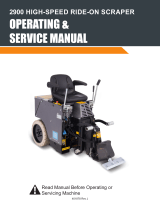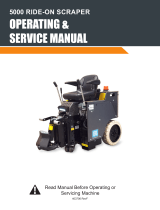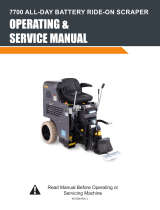
2
2004 by The Toro Company
8111 Lyndale Avenue South
Bloomington, MN 55420-1196
Contact us at www.Toro.com
All Rights Reserved
Printed in the USA
CALIFORNIA
Proposition 65 Warning
Diesel engine exhaust and some of its constituents
are known to the State of California to cause
cancer, birth defects, and other reproductive
harm.
Warning
Because in some areas there are local, state, or federal
regulations requiring that a spark arrester be used on the
engine of this mower, a spark arrester is incorporated with
the muffler assembly.
Important This engine is equipped with a spark
arrester muffler. It is a violation of California Public
Resource Code Section 4442 to use or operate this engine
without a spark arrester muffler on any forest–covered,
brush–covered or grass–covered land. Other states or
federal areas may have similar laws.
This spark ignition system complies with Canadian
ICES-002.
Ce système d’allumage par étincelle de véhicule est
conforme à la norme NMB-002 du Canada.
The enclosed Engine Owner’s Manual is supplied for
information regarding The U.S. Environmental
Protection Agency (EPA) and the California Emission
Control Regulation of emission systems, maintenance
and warranty.
Keep this engine Owner’s Manual with your unit.
Should this engine Owner’s Manual become damaged
or illegible, replace immediately. Replacements may be
ordered through the engine manufacturer.
Contents
Page
Introduction 3. . . . . . . . . . . . . . . . . . . . . . . . . . . . . . . .
Safety 3. . . . . . . . . . . . . . . . . . . . . . . . . . . . . . . . . . . . .
Safe Operating Practices 3. . . . . . . . . . . . . . . . . . .
Slope Chart 7. . . . . . . . . . . . . . . . . . . . . . . . . . . . . .
Safety and Instruction Decals 9. . . . . . . . . . . . . . .
Operation 15. . . . . . . . . . . . . . . . . . . . . . . . . . . . . . . . . .
Using the Rollover Protection System (ROPS) 15. .
Think Safety First 16. . . . . . . . . . . . . . . . . . . . . . . .
Adding Fuel 17. . . . . . . . . . . . . . . . . . . . . . . . . . . . .
Checking the Engine Oil Level 17. . . . . . . . . . . . . .
Controls 18. . . . . . . . . . . . . . . . . . . . . . . . . . . . . . . .
Understanding the Audible Alarms 18. . . . . . . . . . .
Operating the Parking Brake 19. . . . . . . . . . . . . . . .
Page
Starting and Stopping the Engine 19. . . . . . . . . . . .
Operating the Power Take Off (PTO) 21. . . . . . . . .
The Safety Interlock System 21. . . . . . . . . . . . . . . .
Driving Forward or Backward 22. . . . . . . . . . . . . . .
Stopping the Machine 22. . . . . . . . . . . . . . . . . . . . .
Adjusting the Height-of-Cut 23. . . . . . . . . . . . . . . .
Using the Lift Assist Lever 23. . . . . . . . . . . . . . . . .
Adjusting the Anti-Scalp Rollers 23. . . . . . . . . . . . .
Adjusting the Flow Baffle 24. . . . . . . . . . . . . . . . . .
Positioning the Flow Baffle 25. . . . . . . . . . . . . . . . .
Positioning the Seat 25. . . . . . . . . . . . . . . . . . . . . . .
Unlatching the Seat 26. . . . . . . . . . . . . . . . . . . . . . .
Pushing the Machine by Hand 26. . . . . . . . . . . . . . .
Using the Side Discharge 27. . . . . . . . . . . . . . . . . . .
Transporting the Machine 27. . . . . . . . . . . . . . . . . .
Loading Machines 27. . . . . . . . . . . . . . . . . . . . . . . .
Using the Z Stand 28. . . . . . . . . . . . . . . . . . . . . . . . .
Tips for Mowing Grass 30. . . . . . . . . . . . . . . . . . . .
Maintenance 31. . . . . . . . . . . . . . . . . . . . . . . . . . . . . . . .
Recommended Maintenance Schedule 31. . . . . . . .
Servicing the Cutting Blades 32. . . . . . . . . . . . . . . .
Servicing the Air Cleaner 34. . . . . . . . . . . . . . . . . .
Servicing the Engine Oil 35. . . . . . . . . . . . . . . . . . .
Changing the Engine Oil Filter 37. . . . . . . . . . . . . .
Servicing the Cooling System 37. . . . . . . . . . . . . . .
Servicing the Fuel Filter 39. . . . . . . . . . . . . . . . . . .
Servicing the Fuel Tank 40. . . . . . . . . . . . . . . . . . . .
Greasing and Lubrication 40. . . . . . . . . . . . . . . . . . .
Greasing the Spindles 40. . . . . . . . . . . . . . . . . . . . .
Checking the Tire Pressure 42. . . . . . . . . . . . . . . . .
Servicing the Hydraulic System 42. . . . . . . . . . . . .
Adjusting the Handle Neutral 44. . . . . . . . . . . . . . .
Setting the Hydraulic Pump Neutral 45. . . . . . . . . .
Adjusting the Tracking 46. . . . . . . . . . . . . . . . . . . .
Adjusting the Caster Pivot Bearing 46. . . . . . . . . . .
Checking the Wheel Hub Slotted Nut 47. . . . . . . . .
Leveling the Mower at Three Positions 47. . . . . . . .
Cleaning Under the Deck 49. . . . . . . . . . . . . . . . . . .
Inspecting the Belts 50. . . . . . . . . . . . . . . . . . . . . . .
Replacing the Mower Belt 50. . . . . . . . . . . . . . . . . .
Replacing the Drive Belts 50. . . . . . . . . . . . . . . . . .
Adjusting the Drive Belts 51. . . . . . . . . . . . . . . . . .
Replacing the Pump Drive Belt 51. . . . . . . . . . . . . .
Replacing the Fan Drive Belt 52. . . . . . . . . . . . . . .
Replacing and Tensioning the Alternator Belt 52. .
Adjusting the Parking Brake 53. . . . . . . . . . . . . . . .
Servicing the Fuses 53. . . . . . . . . . . . . . . . . . . . . . .
Servicing the Battery 54. . . . . . . . . . . . . . . . . . . . . .
Replacing the Grass Deflector 55. . . . . . . . . . . . . . .























